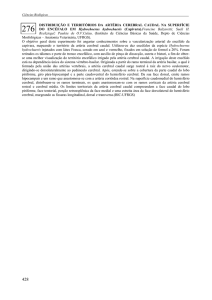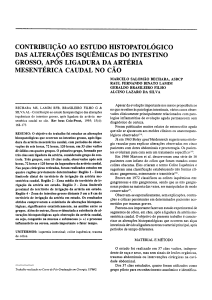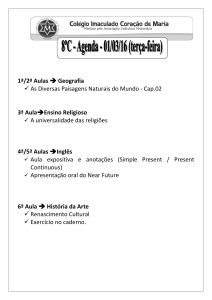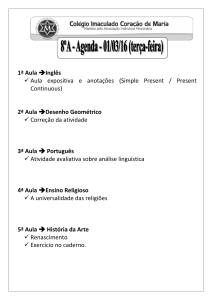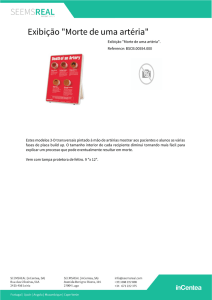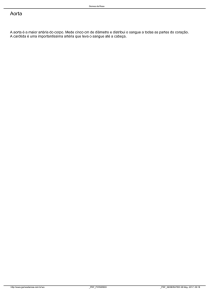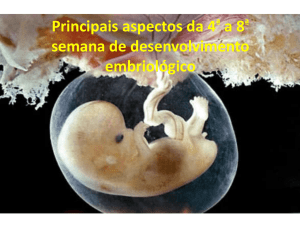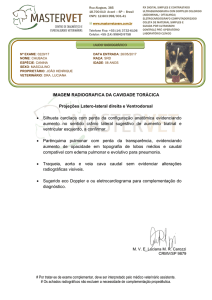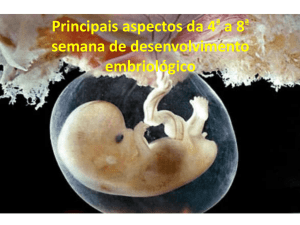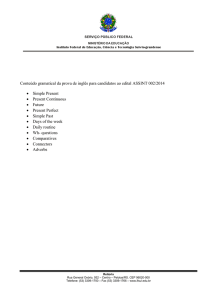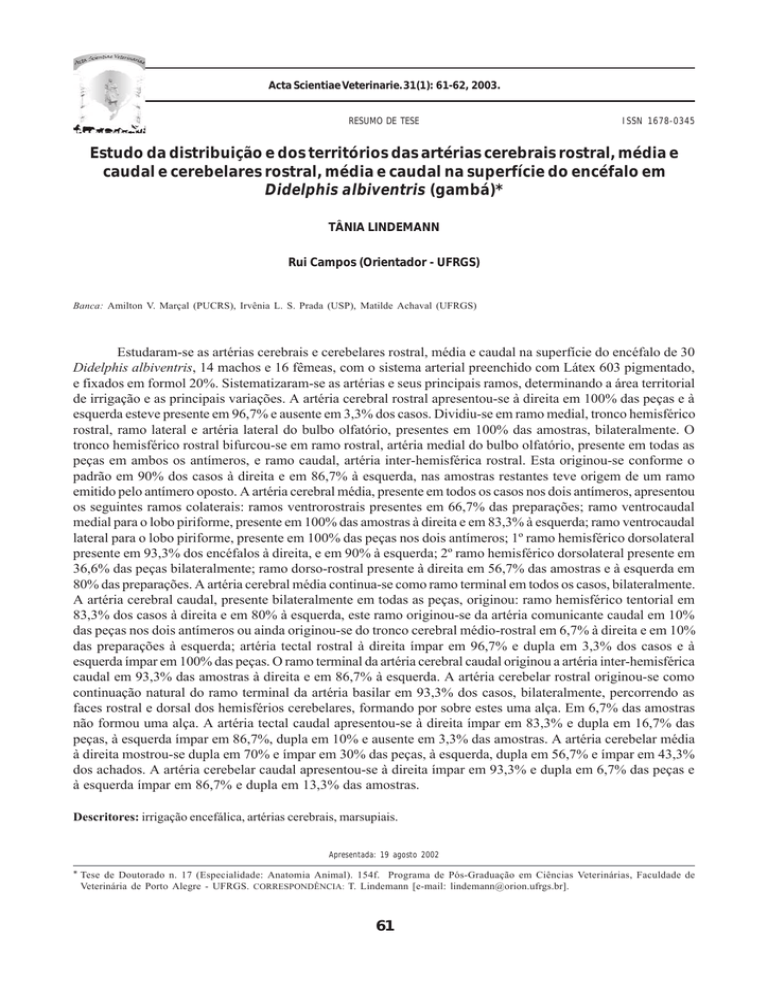
Acta Scientiae Veterinarie. 31(1): 61-62, 2003.
RESUMO DE TESE
ISSN 1678-0345
Estudo da distribuição e dos territórios das artérias cerebrais rostral, média e
caudal e cerebelares rostral, média e caudal na superfície do encéfalo em
Didelphis albiventris (gambá)*
TÂNIA LINDEMANN
Rui Campos (Orientador - UFRGS)
Banca: Amilton V. Marçal (PUCRS), Irvênia L. S. Prada (USP), Matilde Achaval (UFRGS)
Estudaram-se as artérias cerebrais e cerebelares rostral, média e caudal na superfície do encéfalo de 30
Didelphis albiventris, 14 machos e 16 fêmeas, com o sistema arterial preenchido com Látex 603 pigmentado,
e fixados em formol 20%. Sistematizaram-se as artérias e seus principais ramos, determinando a área territorial
de irrigação e as principais variações. A artéria cerebral rostral apresentou-se à direita em 100% das peças e à
esquerda esteve presente em 96,7% e ausente em 3,3% dos casos. Dividiu-se em ramo medial, tronco hemisférico
rostral, ramo lateral e artéria lateral do bulbo olfatório, presentes em 100% das amostras, bilateralmente. O
tronco hemisférico rostral bifurcou-se em ramo rostral, artéria medial do bulbo olfatório, presente em todas as
peças em ambos os antímeros, e ramo caudal, artéria inter-hemisférica rostral. Esta originou-se conforme o
padrão em 90% dos casos à direita e em 86,7% à esquerda, nas amostras restantes teve origem de um ramo
emitido pelo antímero oposto. A artéria cerebral média, presente em todos os casos nos dois antímeros, apresentou
os seguintes ramos colaterais: ramos ventrorostrais presentes em 66,7% das preparações; ramo ventrocaudal
medial para o lobo piriforme, presente em 100% das amostras à direita e em 83,3% à esquerda; ramo ventrocaudal
lateral para o lobo piriforme, presente em 100% das peças nos dois antímeros; 1º ramo hemisférico dorsolateral
presente em 93,3% dos encéfalos à direita, e em 90% à esquerda; 2º ramo hemisférico dorsolateral presente em
36,6% das peças bilateralmente; ramo dorso-rostral presente à direita em 56,7% das amostras e à esquerda em
80% das preparações. A artéria cerebral média continua-se como ramo terminal em todos os casos, bilateralmente.
A artéria cerebral caudal, presente bilateralmente em todas as peças, originou: ramo hemisférico tentorial em
83,3% dos casos à direita e em 80% à esquerda, este ramo originou-se da artéria comunicante caudal em 10%
das peças nos dois antímeros ou ainda originou-se do tronco cerebral médio-rostral em 6,7% à direita e em 10%
das preparações à esquerda; artéria tectal rostral à direita ímpar em 96,7% e dupla em 3,3% dos casos e à
esquerda ímpar em 100% das peças. O ramo terminal da artéria cerebral caudal originou a artéria inter-hemisférica
caudal em 93,3% das amostras à direita e em 86,7% à esquerda. A artéria cerebelar rostral originou-se como
continuação natural do ramo terminal da artéria basilar em 93,3% dos casos, bilateralmente, percorrendo as
faces rostral e dorsal dos hemisférios cerebelares, formando por sobre estes uma alça. Em 6,7% das amostras
não formou uma alça. A artéria tectal caudal apresentou-se à direita ímpar em 83,3% e dupla em 16,7% das
peças, à esquerda ímpar em 86,7%, dupla em 10% e ausente em 3,3% das amostras. A artéria cerebelar média
à direita mostrou-se dupla em 70% e ímpar em 30% das peças, à esquerda, dupla em 56,7% e ímpar em 43,3%
dos achados. A artéria cerebelar caudal apresentou-se à direita ímpar em 93,3% e dupla em 6,7% das peças e
à esquerda ímpar em 86,7% e dupla em 13,3% das amostras.
Descritores: irrigação encefálica, artérias cerebrais, marsupiais.
Apresentada: 19 agosto 2002
* Tese de Doutorado n. 17 (Especialidade: Anatomia Animal). 154f. Programa de Pós-Graduação em Ciências Veterinárias, Faculdade de
Veterinária de Porto Alegre - UFRGS. CORRESPONDÊNCIA: T. Lindemann [e-mail: [email protected]].
61
Acta Scientiae Veterinarie. 31(1): 61-62, 2003.
ABSTRACT OF DISSERTATION
ISSN 1678-0345
Study of distribution and territories of the rostral, middle and caudal cerebral arteries
and rostral, middle and caudal cerebellar arteries on the surface of the brain in
Didelphis albiventris (opossum)**
TÂNIA LINDEMANN
Rui Campos (Adviser - UFRGS)
Committee: Amilton V. Marçal (PUCRS), Irvenia L. S. Prada (USP), Matilde Achaval (UFRGS)
The rostral, middle and caudal cerebral and cerebellar arteries were studied on the surface of the brain
in 30 Didelphis albiventris, 14 males and 16 females, with the arterial system filled with colored latex and fixed
in 20% formaldehyde solution. The arteries and its main branches were systematized, determined the irrigation
territorial area and the main variations. The rostral cerebral artery was seen on the right in 100% of the preparations, on the left it was present in 96.7% and absent in 3.3% of the cases. This vessel was divided into medial
branch (rostral hemispheric trunk) and lateral branch (olfactory bulb lateral artery) present bilaterally in 100% of
samples. The rostral hemispheric trunk bifurcated into a rostral branch, olfactory bulb medial artery, present in
all pieces in both antimeres and in a caudal branch, rostral inter-hemispheric artery. The latter was originated
according to the pattern on the right in 90% of the cases and on the left in 86.7%, and on the remaining samples
was originated from a branch emitted by the opposite antimere. The middle cerebral artery, present in all cases
in both antimeres, showed the following collateral rami: the ventrorostral branches in 66.7% of the pieces; the
medial ventrocaudal ramus present in 100% of the samples on the right and 83.3% on the left; the lateral
ventrocaudal ramus present in 100% of the samples in both antimeres; the 1º dorsolateral hemispheric branch
present in 93.3% of the cases on the right and in 90% on the left; 2º dorsolateral hemispheric branch present
bilaterally in 36.6% of the pieces; the dorsorostral branch present on the right in 56.7% and on the left in 80% of
the preparations. The middle cerebral artery went on as a terminal ramus bilaterally in all cases. The caudal
cerebral artery present bilaterally in all pieces originated: the tentorial hemispheric branch in 83.3% of the cases
on the right and 80% on the left, this branch was originated from the caudal communicating artery in 10% of the
pieces in both antimeres or yet was originated from the rostral-middle cerebral trunk in 6.7% on the right and in
10% on the left; the rostral tectal artery on the right single in 96.7% and double in 3.3% of the cases and on the
left single in 100% of the pieces. The terminal branch of the caudal cerebral artery originated the caudal interhemispheric artery in 93.3% of the samples on the right and in 86.7% on the left. The rostral cerebellar artery
was originated as a natural continuation of the terminal branch of the basilar artery in 93.3% of the cases,
bilaterally, running to the dorsal and rostral surfaces of the lateral cerebellar hemispheres and forming right
above it a loop. The caudal tectal artery was present single on the right in 83.3% and double in 16.7% of the
pieces, on the left single in 86.7%, double in 10% and absent in 3.3% of the samples. The middle cerebellar
artery on the right was seen double in 70% and single in 30% of the preparations, on the left double in 56.7% and
single in 43.3% of the findings. The caudal cerebellar artery was present single on the right in 93.3% and double
in 6.7% of the pieces and on the left single in 86.7% and double in 13.3% of the cases.
Key words: encefalic irrigation, cerebral arteries, marsupials.
Presented: 19 august 2002
** Doctoral Dissertation no. 17 (Field: Veterinary Anatomy). 154p. Postgraduate Program in Veterinary Sciences, Faculdade de Veterinária de Porto
Alegre, Universidade Federal do Rio Grande do Sul (UFRGS) - Brazil. CORRESPONDENCE: T. Lindemann [e-mail: [email protected]].
62

